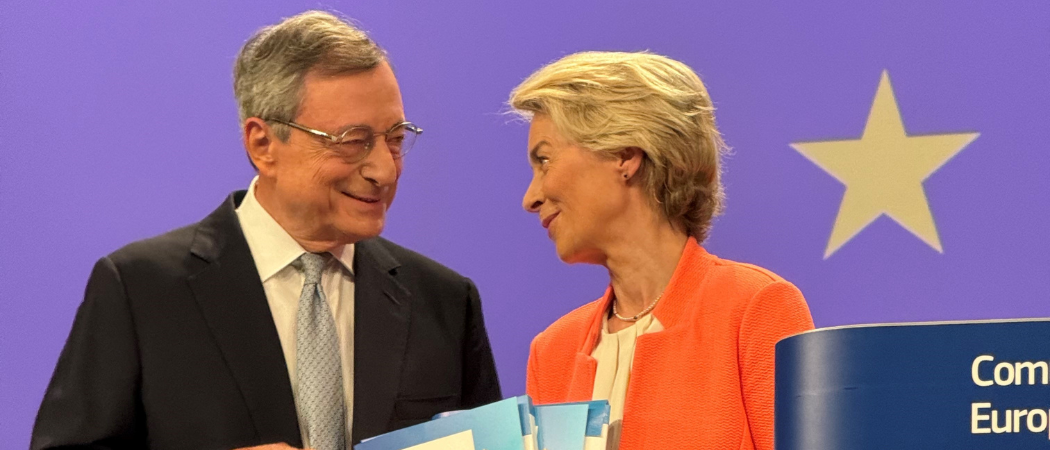Former Italian PM Draghi calls for €200 billion EU budget for research and innovation, provided big reforms are made. EU competitiveness is at stake

Former Italian Prime Minister Mario Draghi handing over his competitiveness report to EU Commission President Ursula von der Leyen. Photo credit: Eleonora Francica, Science|Business
A long-awaited report by one of Europe’s heavyweight politicians, Mario Draghi, put some extra muscle behind a push to spend more on innovation in order to boost EU competitiveness. But it also criticised existing EU programmes as bureaucratic and underfunded.
The report, from a man who won plaudits as Italian prime minister and president of the European Central Bank, urged a doubling of the EU’s flagship research and innovation budget to €200 billion in the next seven-year planning cycle, from 2028-2034. At the same time, however, Draghi said the current programme, Horizon Europe, is too difficult for many applicants to navigate, its public-private partnerships are inefficient, and changes are needed in its main funder for innovative companies, the European Innovation Council (EIC).
The report’s significance comes partly from the author, and partly from the timing – arriving as a new European Parliament and Commission get settled in this autumn, and a broad rewrite of EU policies affecting industry and competitiveness is coming. Nor surprisingly given its pro-spending message, most R&D lobbies responded to the report with praise – but there was little immediate reaction to the report’s criticisms.
The report says a wide gap in gross domestic product has opened between the EU and US, driven by lagging productivity growth in Europe – largely explained by its weak tech sector. In the coming decades, growth will no longer come from rising populations, but will have to be driven by increased productivity.
It identifies three areas for action: closing the innovation gap with the US and China; developing a joint plan for decarbonisation and competitiveness; and enhancing security and reducing dependencies.
The innovation gap
Draghi highlights Europe’s longstanding problem: it is failing to translate innovation into commercialisation, while many of the most innovative startups prefer to seek venture capital and growth opportunities in the US due to EU regulatory hurdles.
“Europe must become a place where innovation flourishes, especially for digital tech. A weak tech sector […] will not only rob us of the growth opportunities of the coming AI revolution, it will also hinder innovation in our traditional sectors,” he told journalists in a briefing about the report.
The report backs a big boost in EU R&I spending – provided the programmes change. “Conditional on reforms, the budget of the new Framework Programme should be doubled to €200 billion per 7 years,” the report recommends, in a boost to research lobbies that have been campaigning for such a budget increase for several months.
But the report proposes harsh medicine. It says the current R&I programme, Horizon Europe, spreads resources too thinly across too many fields, while accessing funding is “excessively difficult”, especially for newcomers. The process for determining priorities and allocating budgets is also overly complex, while the public-private partnerships are “inefficiently designed” and fall short of their potential.
Meanwhile, the European Innovation Council’s Pathfinder instrument, which supports breakthrough innovation at low technology readiness levels, had a budget of €250 million in 2024, which the report points out is much lower than similar agencies in the US and the UK, and is mostly led by EU officials rather than top scientists and innovation experts.
The next programme, provisionally called Framework Programme 10, will therefore have an important role to play in closing the innovation gap. The programme should be focused on a smaller number of priorities, with an increased share of the budget dedicated to disruptive innovation, according to the report.
To oversee this, it recommends reforming the EIC along the lines of the US advanced research project agencies (ARPAs), which support high-risk projects. The application process should also be faster and less bureaucratic, and the programme should be managed by project managers.
Fragmented spending
Part of the EU innovation problem, the report suggests, is the way public spending on R&I is fragmented across the member states, with only a tenth of the total spending managed in Brussels through EU-wide programmes. Draghi calls for a ‘Research and Innovation Union’ to be established to enable a more coordinated R&I strategy, although it is unclear what this would entail.
Two decades after the EU set member states the target of increasing public and private R&D expenditure to at least 3% of GDP, the EU average remains approximately 2.2%. Draghi is urging the EU to reaffirm its commitment to the target “within a defined timeframe”.
When asked by Science|Business about member states missing the 3% target, Draghi said: “We proclaimed that innovation was at the centre of our action, and then we did basically did everything we could to keep it at a low level.”
Among the barriers to innovation in Europe is the “middle technology trap” - an economy based around mature sectors, notably the automotive industry, characterised by low innovation and low productivity. The picture in the US was similar in the early 2000s, but today the top investors in R&I in the US are not from the car industry, but from tech.
The result is that in 2021, EU companies spent around half as much on R&I as a share of GDP as US companies. Earlier this year, a group of economists studied the “middle technology trap” and came to similar conclusions, recommending reforming the EIC along the ARPA model.
Europe is traditionally strong when it comes to basic research, but the report highlights a paucity of European institutions in the top 50 for publications in top academic science journals – just three, compared to 15 in China and 21 in the US – and the lack of top innovation clusters driving commercialisation.
It recommends doubling support for fundamental research through the European Research Council (ERC); introducing an “excellence-based, highly competitive ‘ERC for Institutions’ programme” to provide more resources to academic institutions; and creating an ‘EU Chair’ position to retain top academics by hiring them as European officials.
Single market
Draghi also wants to support the transition from invention to commercialisation, by adopting a “new blueprint for fair and transparent royalty sharing” between researchers and their institutions, rolling out the Unitary Patent in all EU member states, and allowing companies to adopt an EU-wide ‘Innovative European Company’ status.
According to the report, a fragmented single market is preventing innovative firms from scaling up in Europe. This echoes what some of the new MEPs have been saying about EU’s lagging innovation performance. Danish MEP Stine Bosse told Science|Business the issue is not necessarily the amount of public funding, but rather structural problems, like burdensome regulations, that are holding back EU competition and company growth.
During the briefing with journalists, Draghi accused the EU of over-regulating the tech sector with complex laws like the AI Act and General Data Protection Regulation (GDPR). These are meant to regulate US tech giants, but end up hampering small EU firms which can’t afford to hire staff to comply with the legislation. “We are killing our small companies,” he said.”
Draghi’s is the second influential report in recent months to address key challenges related to competitiveness and innovation. In April, another former Italian prime minister, Enrico Letta, published his recommendations for the future of the EU’s single market, including the creation of a “fifth freedom” dedicated to the free movement of research, innovation, knowledge and education.
Decarbonisation and security
Another proposed area for action is a “joint plan spanning industries that produce energy and those that enable decarbonisation such as clean tech and automotives”, in order to bring down energy costs and unlock growth.
Clean tech innovation is suffering from the lack of an ambitious industrial strategy in Europe compared to China or the US, the report warns. It presents a series of recommendations, including concentrating financial support for clean tech manufacturing on technologies where the EU has strong potential for growth, such as in batteries.
The report lists as another overarching objective a need to reduce dependencies, both in terms of key technologies and raw materials, and when it comes to security.
In the defence sector, the main priority is to better aggregate demand and coordinate spending, which is the objective of recent EU initiatives in this domain. The report also accuses Europe of dedicating an insufficient share of its defense spending to R&D – around 4.5%, compared to 16% in the US.
'Spot on’
Draghi’s report was warmly received by the R&I community and interested policymakers. Outgoing research commissioner Iliana Ivanova said: “I support his call for framework conditions that enable stronger and more coordinated public and private investments into research and innovation, including through the EU framework programme.
“Simplification and efficiency of our investments has always been a priority for me, as well as ensuring we focus where action at European level adds most value,” she added.
German MEP Christian Ehler, who was the European Parliament’s co-rapporteur for Horizon Europe, said: “Mr Draghi's analysis and solutions are spot on. If Europe does not get its R&I engine running, our way of life is at risk. We need more disruptive innovation and should gear our R&I policy, our competition policy, our digital policy and our skills policies towards this objective.”
For FP10, that means more money for the ERC and EIC, programmes run by people with a proven track record in the field, less bureaucracy, and better alignment with national and private sector initiatives, he said. “FP10 needs to be an expert-driven and agile R&I programme, which is guided by the logics of science, research and innovation instead of by even stronger and more centralised policy driven programming as some in the Commission seem to favor."
Robert-Jan Smits, president of the executive board of the Eindhoven University of Technology and former director general of research and innovation at the European Commission, said he found Draghi’s criticisms of Horizon Europe “too harsh”, but added: “I agree with the fact that things are complex and time consuming.”
Smits welcomed the focus on innovation as the top priority, as well as the “long overdue” plea to reduce dependencies and increase security. “It’s also good news that Europe’s green ambitions are upheld but that these are no longer to be realised at the expense of industry but in partnership with industry. This means a break with the mainly legislative approach of the Green Deal,” he said.
European Commission President Ursula von der Leyen said her discussions with Draghi had already influenced her political guidelines for the new mandate, including the proposal for a Clean Industrial Deal, and the report would feed into the mission letters she will address to future commissioners.
“The challenge now is to get agreement between the member states about the required funds. The frugal states will not be keen on more debts and certainly not at EU level,” Smits said.
Overall, the investment needs identified in the report would require an additional €750-800 billion per year, equivalent to 4.4 to 4.7% of EU GDP, which is “unprecedented from a historical perspective”, according to the authors.





 A unique international forum for public research organisations and companies to connect their external engagement with strategic interests around their R&D system.
A unique international forum for public research organisations and companies to connect their external engagement with strategic interests around their R&D system.